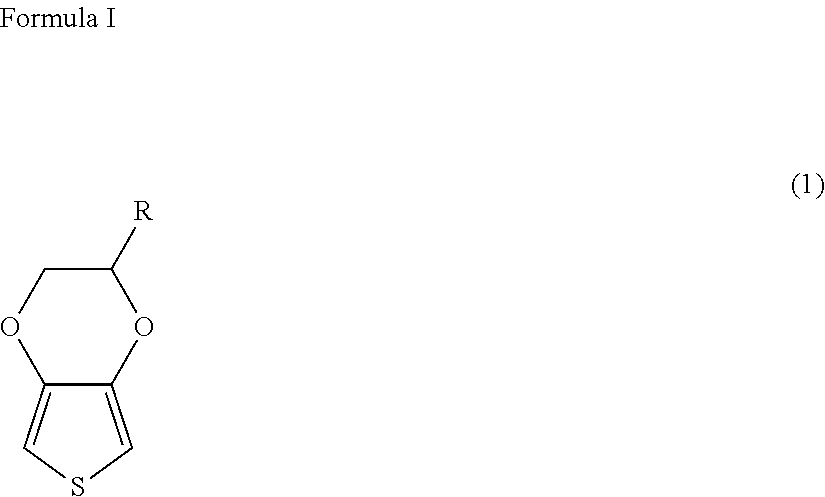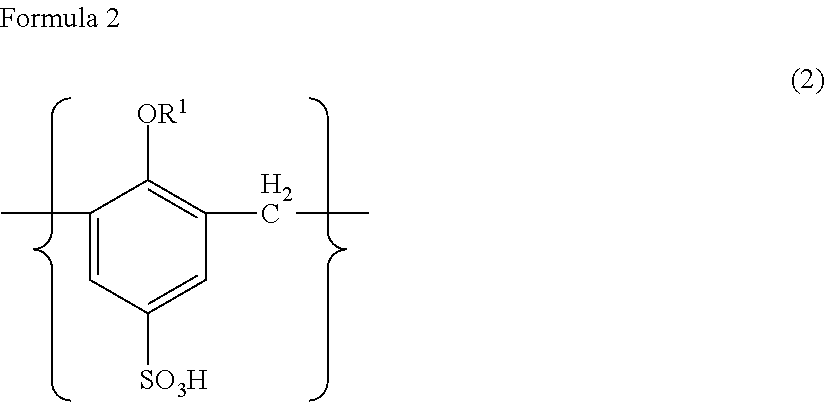Dispersion of electrically conductive polymer, and electrically conductive polymer and use thereof
a technology of electrically conductive polymer and dispersion liquid, which is applied in the direction of conductive materials, capacitor electrolytes/absorbents, electrical apparatus, etc., can solve the problems of inability to fully satisfy the initial resistance value and heat resistance requirements, the conductive polymer obtained by chemical oxidation polymerization is usually not soluble in solvent, and the characteristics cannot be fully satisfied. , to achieve the effect of high conductivity, excellent heat resistance and high reliability
- Summary
- Abstract
- Description
- Claims
- Application Information
AI Technical Summary
Benefits of technology
Problems solved by technology
Method used
Image
Examples
production example 1
Production of Copolymer (Styrenesulfonic Acid: Hydroxyethyl Methacrylate=9:1)
[0098]Production Example 1 produced a copolymer of monomers consisting of styrenesulfonic acid and hydroxyethyl methacrylate (i.e., methacrylate) at a mass ratio of 9:1 at the time of the beginning of the use, as explained below. In the subsequent Production Examples of Production Example 1, the mass ratio of the monomers in the indication of the composition of the copolymers is at the time of the beginning of the use.
[0099]1 L of pure water was added in a separable flask with a stirrer with a volume of 2 L, into which 201.5 g of sodium styrenesulfonate (including 180 g of the styrenesulfonic acid content) and 20 g of hydroxyethyl methacrylate were added. The, 1 g of ammonium persulfate as an oxidant was added into the solution. there, polymerization reaction of styrenesulfonic acid and hydroxyl methacrylate was conducted for 12 hours.
[0100]Then, into the reaction liquid, 100 g of cation exchange resin [AMB...
production example 2
Production of Copolymer (Styrenesulfonic Acid:Hydroxyethyl Methacrylate=8:2)
[0102]Production Example 2 produced of copolymer of monomers consisting of styrenesulfonic acid and hydroxyethyl methacrylate at a mass ratio of 8:2, as explained below.
[0103]1 L of pure water was added in a separable flask with a stirrer with a volume of 2 L, into which 173.5 g of sodium styrenesulfonate (including 155 g of the styrenesulfonic acid content) and 33 g of hydroxyethyl methacrylate were added. Then, 1 g of ammonium persulfate was added into the solution to conduct a polymerization reaction of styrenesulfonic acid and hydroxyl methacrylate for 12 hours.
[0104]Then, into the reaction liquid, 100 g of cation exchange resin [AMBERLITE 120B (a commercial name)] manufactured by Organo Corporation was added, and stirred with a stirrer for one hour. Then, it was filtered with filter paper No. 131 manufactured by Toyo Roshi Kaisha, Ltd. The treatment by the cation exchange resin and the filtration was re...
production example 3
Production of Copolymer (Styrenesulfonic Acid:Hydroxyethyl Methacrylate=4:6)
[0106]Production Example 3 produced a copolymer of monomers consisting of styrenesulfonic acid and hydroxyethyl methacrylate at a mass ratio of 4:6, as explained below.
[0107]1 L of pure water was added in a separable flask with a stirrer with a volume of 2 L, into which 89.6 g of sodium styrenesulfonate (including 80 g of the styrenesulfonic acid content) and 120 g of hydroxyethyl methacrylate were added. Then, 1 g of ammonium persulfate was added into the solution to conduct a polymerization reaction of styrenesulfonic acid and hydroxyl methacrylate for 12 hours.
[0108]Then, into the reaction liquid, 100 g of cation exchange resin [AMBERLITE 120B (a commercial name)] manufactured by Organo Corporation was added, and stirred with a stirrer for one hour. Then, it was filtered with the filter paper No. 131 manufactured by Toyo Roshi Kaisha, Ltd. The treatment by the cation exchange resin and the filtration was ...
PUM
| Property | Measurement | Unit |
|---|---|---|
| boiling point | aaaaa | aaaaa |
| carbon number | aaaaa | aaaaa |
| carbon number | aaaaa | aaaaa |
Abstract
Description
Claims
Application Information
 Login to View More
Login to View More - R&D
- Intellectual Property
- Life Sciences
- Materials
- Tech Scout
- Unparalleled Data Quality
- Higher Quality Content
- 60% Fewer Hallucinations
Browse by: Latest US Patents, China's latest patents, Technical Efficacy Thesaurus, Application Domain, Technology Topic, Popular Technical Reports.
© 2025 PatSnap. All rights reserved.Legal|Privacy policy|Modern Slavery Act Transparency Statement|Sitemap|About US| Contact US: help@patsnap.com


